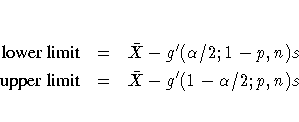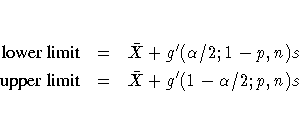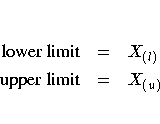Chapter Contents
Previous
Next
|
Chapter Contents |
Previous |
Next |
| PROC CAPABILITY and General Statements |
The CAPABILITY procedure automatically computes the 1st, 5th, 10th, 25th, 50th, 75th, 90th, 95th, and 99th percentiles (quantiles), as well as the minimum and maximum of each analysis variable. To compute percentiles other than these default percentiles, use the PCTLPTS= and PCTLPRE= options in the OUTPUT statement.
You can specify one of five definitions for computing the percentiles with the PCTLDEF= option. Let n be the number of nonmissing values for a variable, and let x1, x2, ... , xn represent the ordered values of the variable. Let the t th percentile be y, set p = [t/100], and let
where j is the integer part of np, and g is the fractional part of np. Then the PCTLDEF= option defines the t th percentile, y, as described in the following table:
| PCTLDEF= | Description | Formula |
| 1 | weighted average at xnp | y = (1-g)xj+gxj+1 |
| where x0 is taken to be x1 | ||
| 2 | observation numbered closest to np |  |
| where i is the integer part of np+(1/2) | ||
| 3 | empirical distribution function |  |
| 4 | weighted average aimed | y=(1-g)xj + gxj+1 |
| at x(n + 1) p | where xn + 1 is taken to be xn | |
| 5 | empirical distribution function with averaging |  |

Note that the PCTLDEF= option is not applicable when a WEIGHT statement is used. However, in this case, if all the weights are identical, the weighted percentiles are the same as the percentiles that would be computed without a WEIGHT statement and with PCTLDEF=5.


You can use the CIPCTLDF option
to request confidence limits for percentiles
which are distribution free
(in particular, it is not necessary to
assume that the data are normally distributed).
These limits are described in Section 5.2 of Hahn and
Meeker (1991).
The two-sided ![]() %
confidence limits for the
100p-th
percentile are
%
confidence limits for the
100p-th
percentile are




If you specify
CIPCTLDF( TYPE = LOWER ),
a one-sided
![]() % lower confidence bound is computed
as Xl,
where l is the
largest integer that satisfies the inequality
% lower confidence bound is computed
as Xl,
where l is the
largest integer that satisfies the inequality


Note that confidence limits for percentiles are not computed when a WEIGHT statement is specified.
|
Chapter Contents |
Previous |
Next |
Top |
Copyright © 1999 by SAS Institute Inc., Cary, NC, USA. All rights reserved.